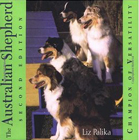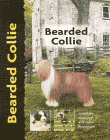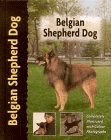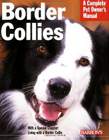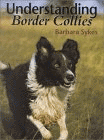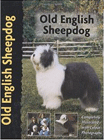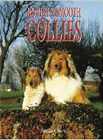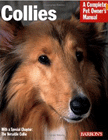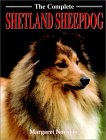Books on Animals: Dogs
Breed books: Herding Dogs
If you want to buy a book, clicking on the book cover will take you directly to that book on the Amazon.co.uk web site.
See also:
- Dogs in recent history and different cultures
- Books on origins, canine evolution and wolves
- Behaviour (canine ethology and behavioural problems)
- Puppy and manners training
- Breeding, grooming and kennel management
- Fiction dealing with dogs
- Skill training: Agility and training games
- Skill training: Sheepdog, gundog and scent work
General overview
All the dogs in this group have been used for herding, in different ways. Border Collies are the best known sheepdogs. Their role as herders involves working in close communication with the shepherd, while at a distance. Pet Border Collies still have this desire to receive orders from their owners, and are very good agility dogs partly because they work so well at a distance, responding to small signals from their owners. Shepherd Dogs, such as the Belgian and German Shepherds, were bred to play a role as flock guardians, as well as being able to herd. Old English Sheepdogs helped drovers take flocks to market, which is a different sort of skill from working with a shepherd on a hillside. They also helped drive cattle, as well as sheep. They are more independent and robust than Border Collies, and this relates back to the work they were designed for. Heelers, like Corgis, were bred to work with cattle rather than sheep, so tended to nip harder, and also work more independently. All these breeds are attentive to their owners to some degree, but some, like Corgis, are more independent than others, and the characters of herding breeds vary. Border Collies and German Shepherds are especially responsive dogs. Both breeds have a strong sense of order, and tend to worry when this order appears to be upset. Belgian shepherds are a little more independent, and have some similarities in how they relate to people as spitz dogs. Bearded Collies and Old English Sheepdogs are more happy-go-lucky, and like to clown, though they can be very headstrong dogs. Rough and Smooth Collies and Shetland Sheepdogs tend to be sensitive, but without the intensity of a Border Collie or many German Shepherd Dogs. Herders are more prone to separation anxiety than most breeds, since they form strong bonds with their owners, and this applies especially to Border Collies and German Shepherds. Pups need to learn how to be alone, so they can cope with being apart from their owners when they are adults.
Two of these breeds have a higher than average risk for being euthanased for behavioural problems, and they are Corgis and Old English Sheepdogs. The risk for Corgis is higher than for Staffordshire Bull Terriers, according to one study. The risk for Old English Sheepdogs is lower than for Corgis, but still higher than for Jack Russell Terriers, another 'challenging' breed. The risk doesn't just relate to what the dog is like, it's also to do with how owners perceive these dogs. Corgis don't look like little terrorists on short legs, after all, the Queen has Corgis! Old English Sheepdogs look unbearably cute and cuddly in adverts. German Shepherd Dogs have a lower than average risk of being euthanased for behavioural problems. Part of the risk difference may be that novice owners don't perceive Corgis and Old English Sheepdogs as challenging dogs, whereas novices have more respect for German Shepherd Dogs, which look like wolves. Novices often just see Corgis and Old English Sheepdogs as cuddly. It's very easy to over-indulge a cuddly-looking dog as a pup, not realising that bad habits learnt while young can create problems later on. Herders are also dogs which need mental stimulation and exercise, so it's no surprise that an overindulged, untrained, bored Corgi will tend to bite people. Old English Sheepdogs are strong dogs, and they need to be trained well as pups, or they can be unmanageable when they are older. Both Corgis and Old English Sheepdogs can be wonderful dogs if they are taught house rules from when they are young, are properly trained, and are given enough to do.
Some herders can be very sensitive to sounds, even to the extent of being sound phobic. These breeds like to have work to do, but they also need peace and quiet, and often don't take well to lots of activity and noise around them when they are not working. Border collies especially benefit from having a safe hidey hole to take refuge in from thunder storms, the hoover, or lots of children rushing around and shouting. Rescue dogs of herding breeds are often overstimulated, so aren't at their best when you get them. They have been unable to work, and left in a noisy environment, often with people constantly passing by, and lots of barking. Your rescue herding dog is quite likely to have a great need of a hidey hole at first!
Good manners are best taught from puppyhood, because it's easier, but adult rescue dogs can still learn fast. The best time to teach good manners to a rescue dog is as soon as the dog arrives. That is when the dog is watching you to learn what the rules are. It's tempting to spoil the dog a bit, because you feel sorry for him or her. But it's kinder in the long run to let the dog know gently and firmly what you consider to be appropriate behaviour. Rescue centres usually have their own behaviourists and provide ongoing help for adopters. Gwen Bailey's 'The Rescue Dog' is also full of good advice.
Dog breeds designed to work closely with their owners, such as German Shepherds and Border Collies, benefit from advanced training. Training these dogs to a high level can help fulfil their potential, and it means that they are more likely to be well-behaved, less likely to get up to mischief on account of being bored. Many Border Collies excel at agility. They can also benefit from learning more thoughtful activities, such as scent work. One great advantage of teaching scent work is that you and your dog can do something interesting indoors on a rainy day. Just being able to do something interesting with an owner is a reward in itself for the dog, and being able to do challenging activities with your dog can be very rewarding for owners too.
Are these breeds good with kids? This depends. It's clear from the above that an overindulged, untrained, bored Corgi or Old English Sheepdog is not the best dog to have in the house with children! Some of these breeds, like Old English sheepdogs and Bearded Collies, are also large and boisterous, and can knock small children over quite easily. A young Beardie and a toddler need a lot of supervision. Herders can also be nippy, especially Border Collies and Corgis. Much depends on the temperament of the individual dog, how well the dog has been trained, and how sensible the children are. Temperament can vary a lot with Border Collies and German Shepherds. Shetland Sheepdogs can be a bit too highly strung for kids, though again they vary, so again it's best to assess the parents of a pup, or the individual dog, if you are considering an adult. Well trained individuals with nice natures from any of these breeds can be very good with kids, and in general terms, Rough Collies are probably the best breed with children. Rough collies do need a fair bit of grooming though!
How about getting on with other dogs? This varies. Some individuals of herding breeds like to play with other dogs, and this is especially true of Bearded Collies, Old English Sheepdogs and Rough Collies. Other individuals can be more aloof with other dogs, being more interested in what their owners are doing, and this applies especially to Border Collies and German Shepherds. Border collies also tend to get on better with other Border Collies than with dogs of different breeds - they speak the same language. Socialization is important with all these breeds. Old English Sheepdogs can be playful, but they can also be dog-aggressive, and this is especially likely if they are not socialized properly with other dogs. Border Collies may stalk and attack other dogs if they aren't socialized, while German Shepherds can be quite nervous of other dogs, and attack any that come near. The trick is to find them suitable canine playmates while they are pups, and to supervise playing sessions so no bullying is allowed by any dog. They also benefit from learning to walk near other dogs and ignore them, when their owner commands - socialization is about more than putting a lot of puppies together!
One health problem that can affect larger breeds is bloat, which can be very serious and even fatal if not treated rapidly. Prevention is better than cure, and dogs should be fed at least twice a day, rather than having just one big meal. They should also rest after eating, rather than being encouraged to play actively, so they have a chance to digest thier food. It used to be thought that raised feeding bowls were a good idea, but ideas have changed, and floor level bowls are seen as better. A tendency to bloat appears to be inherited to some extent, so this is one more reason to check the longevity of the ancestors of any pup you are interested in, and find out what the ancestors died of, and how old they were.
All these breeds need exercise with their owners, and want to be given something to do. You can't just open the back door and tell them to entertain themselves. Like the gundogs, they want you to go out with them. They are all dogs that will keep you fit! They are often the breeds of choice for dog trainers, because they have so much potential. They also tend to be very good obedience and agility dogs, especially the Border Collies, though German Shepherds can perform extremely well in obedience too. Herders tend to pay you more attention than most dogs, and have better recall than most breeds, They are much keener than most dogs on checking where you are, and staying close to you, so they are good dogs to take on walks. They also have great potential for getting into trouble, like herding people or cars, if they are left to their own devices with nothing to do. Taking on a dog from one of these breeds involves a lot of commitment.

New Owner's Guide to Australian Cattle Dogs (New Owner's Guide Series)
Australian Cattle Dogs, also called Queensland Heelers, are for owners with a serious commitment to providing their dogs with interesting activities. Many ACD owners argue that these dogs should really only be used as working dogs, since they need both physical exercise and mental stimulation, and can be destructive, and difficult to manage if they are bored.
They are tough dogs, designed to herd cattle by nipping their heels, so nipping humans can be a problem, especially with children who are not used to playing around herders. Their instincts often lead them to join in games a little too forcefully, trying to 'herd' the kids, especially if children's games involve a lot of running, shouting and screaming. Supervision is essential when children and Australian Cattle Dogs get together, especially when the children are visitors, and don't know the dog. Australian Cattle Dogs do best in households with no children, or with very sensible older children. This is not just because of their habit of nipping, this breed can also be a challenge to train. Consistency in training is especially important with this breed, with the house rules set out from when they are pups. They learn fast, but can learn bad habits as well as good ones, and do not always obey, unless they respect their owners.
They can also be territorial, and wary of human strangers, as well as wanting to fight other dogs, especially those of the same sex. Socialization with humans and other dogs is very important for dogs of this breed, and it should start from when they are pups, and be ongoing. Australian Cattle Dogs have a tendency to chase cats and other small animals. They are barky dogs, and can shed a lot. These dogs were bred to be tough, to do a difficult job under difficult conditions. They have some dingo in their ancestry, which gives them hardiness and vigour, as well as a tough character. Chew toys have to be selected for durability, since dogs of this breed tend to be vigorous chewers, even when they are not in a destructive mood! Generally, Australian Cattle Dogs need owners who are up to the challenges they present.
So why get an Austalian cattle dog? Devotees speak of their intelligence, trainability and loyalty, admire their confidence, energy and stamina. They are dogs that are expressive, and communicate well. They can develop very strong bonds with their owners, picking up on their owners' moods, while retaining independence. They are also very versatile dogs, which have been used for guarding, and agility, as well as herding. They like structure, and seem to understand rules, so if their owners provide them with a clear set of guidelines, and enough to do, they can be very rewarding companions. They also have a short, easy-care coat, which doesn't need a lot of grooming, apart from to remove loose hairs.
Common health problems in this breed include inherited deafness, and eye and hip problems, though they are generally long-lived and healthy dogs.
Narelle Robertson's New Owner's Guide to Australian Cattle Dogs is a good, short introduction to the breed, which uses up to date approaches to behaviour and leadership issues, stressing that ACDs should earn their rewards. It's a good start to understanding the breed, though is unlikely to tell experienced owners much that they don't already know.

The Australian Cattle Dog
Kathy Christian's The Australian Cattle Dog is a comprehensive guide to the breed, covering more ground than Narelle Robertson's book. Some of the training advice could perhaps be improved. For example, there could be more explanations of how owners can tackle behavioural problems, such as barking at other dogs, by teaching the dogs alternative, desired behaviours, and focusing their attention on their owners, rather than simply using corrections. However, this is an excellent guide to Australian Cattle Dogs for owners who are already confident of their training skills.

The Australian Shepherd, Champion of Versatility
Australian shepherds are very attractive, long-coated dogs, which were developed in the US, with some input from Spanish Basque sheep herding dogs in their ancestry. Like all herders, they need physical exercise and mental stimulation, or they can become difficult, and they can also nip children, especially if the children are playing running games. Supervision of herders and children is important, especially if your child has friends round to visit. However, Australian shepherds are quite gentle dogs, and can develop strong bonds with sensible children.
These dogs can be serious herders, but they also have a playful side to their natures, which children can enjoy. Socialization is important for Australian shepherds kept as pets, since they can be a little reserved with strangers. Generally, so long as they are well-trained, and have enough to do, they are well-behaved companions on walks, and can excel in obedience, agility, herding and tracking. Many Aussies are in service as search and rescue dogs as well as herders.
The main drawback of this breed is its vulnerability to health problems. Australian shepherds can be long-lived if they are not afflicted by inherited problems, which are, unfortunately, numerous, and include seizures, cancer, allergies and skin disorders, heart, eye, and hip problems, cancer, and hypothyroidism. It is especially important to check on the ancestry of any pup you are interested in, and to ask how long the pup's ancestors lived, and what health problems they may have had. Diet is also important, given the breed's propensity to allergies.
Liz Palika's Australian Shepherd has some useful advice on training, and on activities that you can enjoy with your dog. The book includes a chapter by Ian Dunbar. There is also help with feeding, grooming, and health issues. It's also a well-illustrated book, with lovely pictures of Aussies.

Bearded Collie (Pet Love)
Bearded collies are very active, friendly dogs, which were developed to work independently, so are not quite as obedient as border collies. They need a fair bit of grooming, not as much as an Old English Sheepdog, which they resemble somewhat, but they do need a good brush at least once a week, and they tend to collect mud on their long coats.
Beardies have a habit of jumping up in order to greet you better, and they are large dogs which can easily knock over small people as they rush past. They are not really suitable for homes with frail, elderly people, or toddlers, unless you can train them very strictly when they are pups. They should also be trained not to nip as pups. They are usually much less nippy than Border Collies, but a Bearded Collie that does nip is much more difficult to control, because they are such fast movers. Well trained Bearded Collies are usually fine with older children, because they are so friendly and playful. They need a lot of exercise, but enjoy retrieving, so can play happily for long periods in the garden. Beardies are also good agility dogs and tend to enjoy agility, sometimes to the extent of doing jumps twice, the second time just for fun. They usually get on well with other dogs, though some dogs find them a bit large and fast moving for comfort. It's easier to match them with a relatively placid breed if you have more than one dog, since two dogs with very high activity levels can be a little wearing!
Bearded Collies can be destructive if bored, tending to strew laundry and get into the rubbish. They also bark more if bored. They are good watchdogs, since they give good alarm barks, though they are then likely to kiss any intruder. They are generally healthy, staying active throughout their lives, though some common problems that the breed can suffer from include allergies, hip dysplasia and hypothyroidism.
Bryony Harcourt-Brown gives a good description of the breed, with advice on training and general care, as well as an account of the history of Bearded Collies. This is a good introduction to the breed for a novice Beardie owner, or someone considering a Bearded Collie.

Belgian Shepherd Dog (Pet Love)
Belgian Shepherd Dogs are becoming increasingly popular, though they are still not very well known. They are an unusual breed with a lot of character. Spitz lovers are likely to feel more at home with Belgian Shepherds than with German Shepherds, since much of this breed's body language is similar to that of a spitz. They come in four varieties. The Groenendael is a long haired black breed and the Tervueren also has a long coat, but is black and red or black and fawn, with the same sort of colour distribution as a German Shepherd. Both these breeds need grooming at least once a week, and they need collars which are kind to their ruffs. The Malinois has similar colours to the Tervueren, but has short hair, and can be mistaken for a German Shepherd, though the body language is different, while the Laekenois is wiry-coated and fawn.
These dogs are increasingly used by police forces worldwide, especially the Malinois, due the problems that have arisen from poor breeding of German Shepherds. Like German Shepherd Dogs, Belgian Shepherds can be over-protective, so they should be trained with care. They are naturally good guard dogs, and should be socialized to be friendly with people when they are pups. They can also be barky dogs, and it's a good idea to teach them how to be quiet while they are pups, trying never to reward barky behaviour and giving rewards, like opening the door to go out, when they are quiet. They also need to understand from day one that playbiting is not permitted.
Are Belgian Shepherd Dogs good with children? Generally, yes, so long as they are well-socialized and well trained. This also applies to their relations with other dogs - Belgian shepherds can be very playful with those dogs they get on with, more playful than the average German Shepherd Dog. They are quite capable of obeying their owners and ignoring a passing dog on walks, though, even if the dog is a friend. Unsocialized Belgian Shepherds can be dog-aggressive, as with any breed, but usually their relations with other dogs are good.
Health problems include eye trouble, though generally this is a healthy breed, especially compared with German Shepherd Dogs.
Robert Pollett has written a good, up-to-date guide to the breed, which helps to understand the character of Belgian Shepherds, as well as giving help with training. There is a lot of information on the history of all four types of Belgian Shepherd Dog, and the book is well illustrated.

Border Collies Complete Owners Manual
Border collies are often described as workaholics. They like to be kept busy, and can become difficult if they are bored. They are the best breed for a number of activities, such as agility and flyball, so much so, that owners of other breeds often don't want to compete against border collies! They are also fine obedience dogs. Not everyone is suited to being a BC owner. You need to be able to commit quite a lot of time to the dog, or use a BC as a working dog, herding sheep.

The Ultimate Border Collie
This book is a complete guide to border collies, with a lot of useful information for owners. It covers origins and history, choosing and raising pups, feeding, breed traits and training, obedience, agility, flyball, herding, other work, breed standards and showing, breeding, collies in different countries, and health and disease.
On the whole, this guide to collies is highly recommended. The chapters on training and working collies give a very clear idea of what collies are like, and what they can do. There is a lot of breed-specific information, for example on their little behavioural quirks, their abilities and vulnerabilities, including diseases associated with the breed.

Understanding Border Collies
This is an extremely useful book for Border Collie owners, because it gives such a clear picture of the breed, the challenges that a Border Collie can present, and is full of useful tips to help you deal with those challenges. You may not agree with all Barbara Sykes' training advice, but it is obvious that she loves the breed, tries to see life from the dog's point of view, stresses common sense, and is results oriented. You can pick and choose which of her training tips to incorporate into your training repertoire.
She links the breed's history very well with the character of Border Collies. There is also very good advice on general care, such as nutrition. The book is well set out, and easy to read. It's very entertaining in parts, and there are many wonderful illustrations. It's a must-read for Border Collie lovers.

The Dog Wars
"The Dog Wars" is the story of a battle by organizations representing owners of working Border collies to prevent the American Kennel Club (AKC) from "recognising" their breed. "Why the fuss?", you might ask. "Surely recognition from an influential body would bring benefits." Well, actually no, according to many breed organizations. For sheepdoggers, like Donald McCaig, the concern is that recognition brings pressures to breed dogs that conform to a particular appearance, the "conformation standard". Yet the essence of border collies lies in their ability to work.
The ISDS, or International Sheepdog Society, will register dogs on merit, for their ability to work, regardless of their parentage or appearance. As anyone who has watched "One Man and His Dog" knows, Border collies come in all shapes, colours, coat types and sizes. A proposal to turn this particular breed into an attractive, but useless dog, conforming to just one particular appearance template for a collie, makes no sense. Border collies are dogs bred to do a particular job. Collies bred for appearance only are therefore not border collies, regardless of their pedigrees.

The Pembroke Welsh Corgi (Happy, Healthy Pet)
Corgis are potentially fine little companion dogs, as well as excellent working dogs, but they are very high in the list of breeds likely to be euthanased for behavioural problems. Why is this? They were bred to herd cattle, and as such have a tendency to nip, hard. Teaching bite inhibition is extremely important with pups of this breed. Corgis that have been trained not to bite people when they are pups make good companions for children, so long as the children don't roughhouse them, but treat them with respect.
Pembroke Corgis are also a very vocal breed, which can be a disadvantage, though they do make good watchdogs. They aren't especially sociable with other dogs, though they can get on well with dogs in the same household, so long as they are well matched. They can perform well as obedience dogs, and are excellent agility performers, often the best in groups of small dogs. They have also been used as tracker dogs. They love attention, and can get up to mischief if left to their own devices for too long. Like all herding dogs, they need an owner with commitment. Common health problems include a tendency towards obesity, and they should be kept slim as pups, since fat pups are more likely to have problems in later life.
Deborah Harper's introduction to the breed gives new owners a very good idea of what to expect, and the illustrations are good. There is also a lot of help with training, which is especially important with this breed.

Everything You Need to Know About German Shepherds
German Shepherd Dogs have long been favourites in the UK. They are very versatile dogs, and play a number of roles, including helping disabled people, and working as police dogs. They are dogs that bond very strongly with their owners, and they can be trained more easily than most breeds, because they have a strong desire to please, though they are less 'forgiving' of mistakes in training than, say. Labrador retrievers.
Read more: Everything You Need to Know About German Shepherds

Training Your German Shepherd Dog
It's very important for owners of German Shepherds to learn about training. Dogs of this breed have great potential for learning, but this means that they can easily pick up bad habits. They are also sometimes too nervous to do well in dog clubs, where they have to cope with a lot of other dogs and people in close proximity. Dan Rice has written a clear guide to help owners get the best from their dogs. which is well illustrated with photographs to help you follow his tips.
Children should be able to follow his advice, so you can involve all the family in your dog's training regime.

Old English Sheepdog
Old English Shepherds are playful, strong-willed, versatile dogs, which need a lot of grooming. They need a lot of commitment because they can be a handful if not properly trained, and if they don't get enough exercise. They are at higher risk of being euthanased for behavioural problems than Jack Russell Terriers. A large breed dog can create more havoc when things go wrong!

Rough and Smooth Collies (Book of the Breed)
Rough Collies became popular with Lassie, and this is one case where popularity in a movie has tended to have a happy outcome. Rough Collies are good family dogs, usually getting on very well with children. They are certainly a far more biddable breed than Dalmations, though they can develop bad habits if they don't get enough exercise and aren't trained properly. They are sensitive dogs, and learn well, so long as their owners are patient. They will tend to shut off if they are shouted at.
They have been used in a number of roles, including herding, search and rescue, and helping disabled people. Rough Collies are also generally outgoing and friendly and tend to get on well with other dogs. One reason they may get on so well with people is that they are so good looking with their long coats, that every passer by wants to pet them, and Rough Collies love this attention.
Smooth Collies are very similar to Rough Collies in terms of character, without the long hair, but they can be a little nervy and shy, and so may need a very gentle but firm approach to training, with no playbiting allowed when they are little so that they are less likely to snap from fear when they are older. It's especially important to check the temperament of Smooth Collie parents of any pup you are interested in.
What is the downside of Rough Collies? They are herders, so do need exercise and mental stimulation, preferably daily walks with their owner. They also need a lot of grooming, with at least one good grooming session every week, or they tend to mat. Many people prefer Smooth Collies because they don't need so much grooming, taking care to choose pups from parents with very good temperaments. Some rough collies can be nervy and a bit over sensitive too, and they can also be very barky.
Common health problems include skin disorders, which are partly hereditary, and can be affected by food and environmental chemicals, and possible sensitivity to some veterinary pharmaceutical products. Eye trouble can also be inherited. This is a good introductory guide to Rough and Smooth Collies, covering their history and general care, including grooming and training.

Collies, Complete Pet Owner's Manual
This is a short, introductory guide to collies, which is very good value, and gives a clear idea of what collies are capable of. It is clearly written, and the photos are lovely. This would make a good present for a child, though a meatier book is perhaps more suitable for an adult wanting to know more about their breed.

The Complete Shetland Sheepdog
Shetland Sheepdogs are like smaller versions of Rough Collies, and are very similar in character, though some can be nervy, and they tend to be noisier. It's a good idea to check out the temperament of a pup's parents, since these dogs do vary in terms of temperament. They are a little delicate for families with children, though they can get on very well with sensible children who respect them. Shetland Sheepdogs are especially suitable for people with experience of dogs who want a smaller breed which likes exercise and is not likely to pull you over on walks. They are popular among retired people who feel they no longer have the strength for a bouncier, larger dog.
They are responsive dogs, so can be very rewarding with owners who have time to spend on them. Shelties are versatile, and can perform well in obedience competitions, as well as enjoying a range of activities. They are less likely to bark and develop other undesirable habits if they have enough to do. They benefit from a daily walk, and enjoy playing games indoors if it's too unpleasant outside for more than a short walk.. These are not dogs to choose because they are cute, and look like they are small enough to live in a flat. They need exercise and mental stimulation, like any herder, and they also need daily grooming, to look their best.
Common health problems include those common to Rough Collies, such as eye trouble, as well as digestive problems. This is a good introductory guide to Shetland Sheepdogs by someone who clearly loves the breed. Their history is covered, and there is a good portrait of their character, as well as useful advice on general care and training.
Latest book reviews
Latest news and research
- Impact of facial conformation on canine health: corneal ulceration
- Prevalence of disorders recorded in dogs attending primary-care veterinary practices in England
- Disease control through fertility control: secondary benefits of animal birth control in Indian street dogs.
- Quantifying sources of environmental contamination with Toxocara spp eggs.
- Clostridium difficile in faeces from healthy dogs and dogs with diarrhea
- Impact of canine overweight and obesity on health-related quality of life
- Effect of a diet enriched with green-lipped mussel on pain behavior and functioning in dogs with clinical osteoarthritis
- Short, unstructured session with a dog reduces anxiety levels in students, and improves their mood
- Research suggests canine companionship helps calm children undergoing cancer treatment
- Dingoes in the dock
Care and behaviour of dogs
- Acknowledgments and further reading
- Aggression
- Appetite Loss
- Attention Seeking
- Barking
- Basic training
- Behavioural problems
- Behavioural problems in dogs
- Being sensible with traffic
- Bitches In Season
- Biting
- Canine Social Cognition, part 1: Dogs are special
- Canine Social Cognition, part 2: Differences between dogs
- Chasing Cars, Bikes, Joggers, Cats etc.
- Choosing a dog
- Coming when called
- Designing and using a dog garden
- Destructiveness
- Do you want your pet dog to have puppies?
- Dogs and diet
- Dogs don’t bite humans
- Dogs: Bringing up your puppy
- Dogs: Helping dogs with sound phobias, and fear of fireworks
- Fighting
- Finding a good training class
- Greeting guests politely
- Jealousy
- Jumping Up
- Learning that some animals are prey, others are not
- Mounting
- Multi-dog households: Enjoying life with more than one dog
- Phobias
- Poo Eating
- Possessiveness
- Recall
- Respecting other dogs in the household
- Respecting passers-by, human and canine
- Separation Anxiety
- Stealing
- There are acceptable and unacceptable places to perform (housetraining)
- Toilet Training
- Travelling safely in cars
- Using Flexileads safely
- Vet Phobias
- Walking nicely on the lead
- Walking On The Lead
- Wolves, Dogs and Humans



